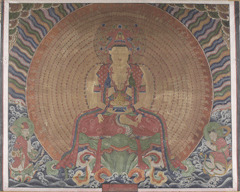Buddhist Painting of Yeonhwasa Temple (Sahasrabhuja Avalokistesvara)
Welcome to Dongdaemun-gu

Buddhist Painting of Yeonhwasa Temple (Sahasrabhuja Avalokitesvara) Seoul Tangible Cultural Heritage No. 344
It is a painting of Sahasrabhuja Avalokitesvara created by Hanbong Eungjak, Bosan Bokju, Cheongam Unjo, Daebeom, Bongjeon, Haebeom and many others, and was created together with the Hanging Painting of Amitabha Buddha, Sinjungdo (Painting of Guardian Deities), Jijangsiwangdo (Painting of Ksitigarbha Bodhisattva and Ten Underworld Kings) and Chilseongdo (Painting of Seven Stars Buddhas) in 1901.
The painting shows 4 arms and 8 arms holding up jeongbyeong and gyeongchaek (remonstration stick)on which willow tree branches are attached, and expresses Sahasrabhuja Avalokitesvara (Thousand Eyes and Hands Bodhisattva) sitting atop the lotus pedestal, which is rising in the middle of a sea, as a main figure.
In the painting, Sudhana Kumāra (Seonjaedongja) and the Dragon King (Yongwang) holding dragon horn stand facing gwaneumbosal. Here, depiction of Sudhana Kumāra on the painting of Sahasrabhuja Avalokitesvara is due to Ipbeopgyepum (Entering the Dharma Realm) of Avatamsaka Sutra (The Flower Garland Sutra) as the painting expresses Sudhana Kumāra visiting Avalokitesvara Bodhisattva in Botarakgasan in his 28th visit of Buddhist priests of high virtue and inquiring of the practice and ways of Buddha.
Moreover, depiction of Dragon King in the in opposite to Sudhana Kumāra seems to follow the style of Suwolgwaneumdo (Painting of Avalokitesvara Bodhisattva) in the late Joseon Dynasty, showing that Cheonsugwaneumdo (Painting of Sahasrabhuja Avalokitesvara) of Yeonhwasa not only maintains the tradition of Cheonsugwaneumdo having passed down from Goryeo Dynasty but also inherits the style of Suwolgwaneumdo from the late Joseon period. The style of Cheonsugwaneumdo of Yeonhwasa was subsequently succeeded by Cheonsugwaneumdo of Daesansa Temple (1925).
For this Buddhist painting, Hanbong Eungjak served as the chief court painter with the assistance of Bosan Bokju, Cheongam Unjo, Daebeom, Bongjeon and Haebeom. Eungjak was a Buddhist painter who was active in Seoul and the Gyeonggi region in the late 19th century and produced paintings at Bongwonsa and Cheongnyongsa Temples in addition to Yeonhwasa Temple. In the beginning, Eungjak worked with other Buddhist painters such as Daeeundang Donhui, Bosandang Bokju, Cheongamdang Unjo, Daebeom and Bongjeon, and comprehensively learned and experienced painting styles in the Seoul region through, for example, performing works using drafts of Gyeongseondang Eungseok, a famous Buddhist painter in Seoul and the Gyeonggi region at the time, showing a representative painting style of that time.
A work that succeeded the style of Cheonsugwaneumdo of Goryeo and Joseon, it is an important piece of work for the research on the trends of Buddhist painting and activities of Buddhist painters active in Seoul and the Gyeonggi region in the 19th and 20th centuries, as there are only a few Cheonsugwaneumdo paintings remaining not just in Seoul but also nationwide.
Information
- Designation No.Seoul Tangible Cultural Heritage No. 344
- Date designatedMarch 7th, 2013
- Management bodyYeonhwasa Temple
- Address56, Kyungheedae-ro 3-gil (Hoegi-dong), Dongdaemun-gu, Seoul
Photo Source : Korea Heritage Service
